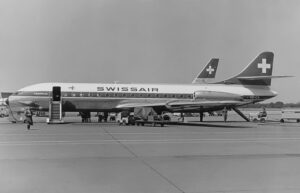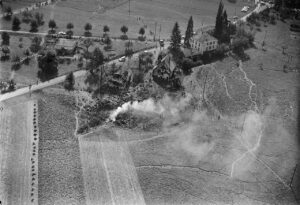 Fog delayed the departure of on September 4, 1963, but the delay was not able to save the plane or its passengers. Swissair Flight 306, a Sud Aviation SE-210 Caravelle III, named Schaffhausen, was scheduled to fly internationally from Zürich to Rome, with a stop in Geneva. Unfortunately, it crashed near Dürrenäsch, Aargau, shortly after take-off, killing all 80 people on board.
Fog delayed the departure of on September 4, 1963, but the delay was not able to save the plane or its passengers. Swissair Flight 306, a Sud Aviation SE-210 Caravelle III, named Schaffhausen, was scheduled to fly internationally from Zürich to Rome, with a stop in Geneva. Unfortunately, it crashed near Dürrenäsch, Aargau, shortly after take-off, killing all 80 people on board.
The plane was due to take off at 06:00 UTC, but the fog was throwing everything off. At 06:04 the flight was allowed to taxi to runway 34 behind an escorting vehicle, to await clearance. Then the crew of Swissair Flight 306, decided to taxi slowly down the runway at 06:05 to inspect the fog. Then they would return to the take off point. Part of the plan was to use high engine power in order to disperse the fog. It must have worked, because around 06:12 the Swissair Flight 306 returned to runway 34 and was allowed to take off. The flight took off at 6:13 and started to climb to flight level 150, which is about 15,000 feet, which would be its cruising altitude.
A short four minutes later, people on the ground witnessed a white trail of smoke coming from the left side of the aircraft. The white streak of smoke gave way to a long flame that erupted from the left wing. Around 06:20 the aircraft reached a height of about 8,900 feet. At that level, the plane began to descend and banking gently to the left before losing altitude more quickly and finally going into a steep and final dive. At 6:21 a frantic mayday message was issued. Then, at 6:22 the Swissair Flight 306 crashed into the ground on the outskirts of Dürrenäsch, approximately 22 miles from Zürich Airport.
So, what brought this plane down just minutes after takeoff. The taxi down the runway in an effort to clear the fog…believe it or not. When the plane went down the runway using full engine power, the pilot also applied the brakes so the plane wouldn’t try to take off. The brakes overheated, causing the magnesium wheels to burst. One of them burst on the runway prior to departure. Then, when the landing gear was retracted, the hydraulic lines in the gear bay were damaged, causing the hydraulic fluid to leak and ignite. The fire damaged the gear bay, and then the wing. Upon looking at the data from the airplane’s flight recorder, it was determined that the crew began experiencing difficulties at 6:18. The data became irregular beginning roughly two minutes later,  indicating that the fire was causing electrical problems. Analysis of the wreckage indicated that parts of the airplane began detaching “with increasing frequency” at about 6:18. The left engine had shut down prior to the crash, but it is uncertain whether this was from crew action, or a failure caused by the fire. The actual cause for the final loss of control was not conclusively determined, but it seems likely that loss of hydraulics played a key part in it. The rigidity of the left wing and rear fuselage, the integrity of the hydraulic flight control system, and the elevator control unit were all noted as possible areas the fire may have affected in the final portion of the flight to an extent which would have caused a rapid loss of control. In the end, all Caravelles were modified to use non-flammable hydraulic fluids, to avoid a recurrence of this tragedy.
indicating that the fire was causing electrical problems. Analysis of the wreckage indicated that parts of the airplane began detaching “with increasing frequency” at about 6:18. The left engine had shut down prior to the crash, but it is uncertain whether this was from crew action, or a failure caused by the fire. The actual cause for the final loss of control was not conclusively determined, but it seems likely that loss of hydraulics played a key part in it. The rigidity of the left wing and rear fuselage, the integrity of the hydraulic flight control system, and the elevator control unit were all noted as possible areas the fire may have affected in the final portion of the flight to an extent which would have caused a rapid loss of control. In the end, all Caravelles were modified to use non-flammable hydraulic fluids, to avoid a recurrence of this tragedy.


Leave a Reply